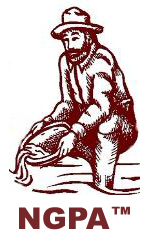How to Pan for Gold

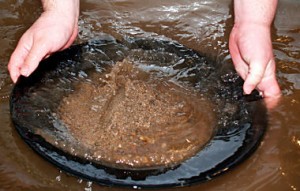 When most people think of panning for gold, they envision grizzled old prospectors who flocked to states like California, Alaska and Georgia in hopes of striking it rich during the great gold rushes of the 1800’s and early 1900’s. Thanks to record high gold prices, though, recreational gold panning is becoming very popular again across the United States.
When most people think of panning for gold, they envision grizzled old prospectors who flocked to states like California, Alaska and Georgia in hopes of striking it rich during the great gold rushes of the 1800’s and early 1900’s. Thanks to record high gold prices, though, recreational gold panning is becoming very popular again across the United States.
Gold panning is an inexpensive hobby to get involved in, is easy to learn, and is a great reason to spend time outdoors and explore nearby wilderness areas. And don’t think that gold panning can only be done successfully in a handful of states! The truth is that gold can be found in one form or another across the country, and you might be surprised to discover that there are active gold prospecting groups in your state that are eager to welcome new members who want to learn about how to find gold.
Gold Panning Won’t Make You Rich
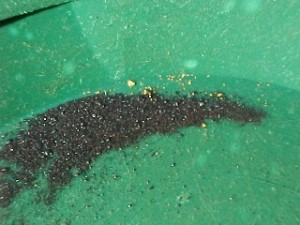 Let’s get one thing straight, though: you shouldn’t get involved in gold panning with the expectation that it will make you rich. In fact, most active gold panning enthusiasts do it primarily because they love being outdoors, exploring local creeks and streams, and sharing their hobby with other amateur prospectors. While it’s possible that you could make a modest profit by panning for gold or even find some valuable nuggets, you need to understand that most prospecting hobbyists don’t ever amass more than a few vials of gold flakes.
Let’s get one thing straight, though: you shouldn’t get involved in gold panning with the expectation that it will make you rich. In fact, most active gold panning enthusiasts do it primarily because they love being outdoors, exploring local creeks and streams, and sharing their hobby with other amateur prospectors. While it’s possible that you could make a modest profit by panning for gold or even find some valuable nuggets, you need to understand that most prospecting hobbyists don’t ever amass more than a few vials of gold flakes.
Gold panning is a the perfect hobby for those of us who already take pleasure from spending time in the great outdoors, camping, hiking and exploring. If you don’t already like these types of recreational activities, then it isn’t likely that gold panning will be something that you enjoy.
Learning How to Pan for Gold
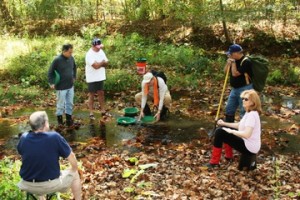 The first step in learning how to pan for gold is to find out whether or not other people have successfully prospected in your area. As I mentioned earlier, you’d be surprised at how many places across the country have gold panning opportunities; you don’t have to live in California or Alaska to find gold. I live in northeast Ohio . . . and although my state isn’t exactly well-known for gold deposits, I was happy to discover that there are creeks and streams within a few miles of my home where people have successfully panned for gold flakes.
The first step in learning how to pan for gold is to find out whether or not other people have successfully prospected in your area. As I mentioned earlier, you’d be surprised at how many places across the country have gold panning opportunities; you don’t have to live in California or Alaska to find gold. I live in northeast Ohio . . . and although my state isn’t exactly well-known for gold deposits, I was happy to discover that there are creeks and streams within a few miles of my home where people have successfully panned for gold flakes.
One great thing about gold panning is that it’s a hobby you can teach yourself how to do without too much help from experienced prospectors. While you shouldn’t pass up the chance to join a local panning group and learn from experts if the option is available, you can easily buy all of the equipment you need and teach yourself how to pan for gold in your spare time.
Additionally, thanks to the Internet, there are countless how-to videos that you can watch on YouTube and other social sharing sites that will show you exactly how experienced prospectors pan for gold in creeks and streams across the country.
Beginner gold panning kits can be purchased online from a variety of different sources, and they include everything you need to get started. Most panning kits will include (at the very least) a plastic gold pan, a gold vial for storing flakes, a plastic snuffer bottle for separating gold flakes from other sediment, and a simple how-to book for getting started in the hobby. You can get a good panning kit for between $50 and $100 online.
The most basic concept in panning for gold is very simple: gold is heavier than other materials you will find in creek beds, and it tends to sink because of its weight. This concept first comes into play when learning about how gold is deposited in creeks and streams. Over time, gold deposits are slowly weathered out of rock by the flow of water, temperature changes, weather and other forces. These particles of gold are washed down streams, where they tend to sink and accumulate in bends, near the creek shore, and in rock crevices. Gold particles, flakes and nuggets that are deposited in creek and stream sediment are called “placer deposits.”
The Process of Panning for Gold
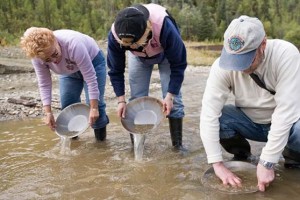 When you pan for placer deposits, you are again using the concept that gold is very heavy to separate it from the rest of the sediment. You should choose a location in a stream that is fairly calm, but where there is still some water flow in order to wash away any muddy, worthless sediment from your pan.
When you pan for placer deposits, you are again using the concept that gold is very heavy to separate it from the rest of the sediment. You should choose a location in a stream that is fairly calm, but where there is still some water flow in order to wash away any muddy, worthless sediment from your pan.
Fill up your pan about halfway with dirt and gravel from the creek bed, then dip it into the creek to add water and get the sediment good and wet. Shake the material vigorously in the pan with a side-to-side motion (remember, gold is heavier than the other material, and this shaking is how we get the flakes to sink to the bottom of the pan).
After your initial vigorous shake, you can get rid of the larger pebbles, rocks and other sediment that remain at the top of your pan. Break up any lumps of mud or dirt that are in the pan, and continue shaking (or “stratifying,” as they call it) the material. The water in your pan is going to get muddy and hard to see through, which is why we chose a place in the stream where there is still some flow; simply dip your pan into the gently flowing water periodically to wash away the mud and get a better view.
After several minutes of this continued rocking, shaking, rinsing and discarding process, you’re going to discover that you have only a little bit of dark material left in the bottom of the pan. This material will get progressively darker as you continue to gently shake and remove lighter sediment from the pan, because it mainly consists of iron. You’ll want to take your time now to ensure that your gold doesn’t wash away while you stratify the iron sand, shake it, and gradually rinse it out of your pan.
When you get down to only a few teaspoons of black iron sand left in your pan, you might start to notice a few flakes of bright gold among the other sediment. Although you can continue to stratify and shake the last few spoonfuls of black sand, many amateur gold panners take this material home to separate the gold flakes from the iron. Plastic snuffer bottles–which allow you to carefully suck the small gold flakes out of the pan–and even magnets are sometimes used to separate the iron and the gold.
Admittedly, this is a fairly simple description of how to pan for gold, and your own methods will gradually improve as you get a feel for how to stratify the sediment with your pan. Not every gold panning session will end with you having gold in your pan; in fact, it can take many tries before you finally find your first gold flakes or particles. If you know that gold has been panned from a particular creek or stream, keep trying . . . if it was found there before, then it can be found there again.

